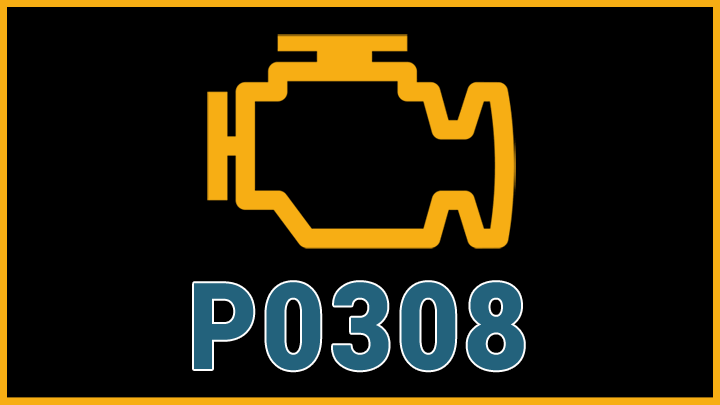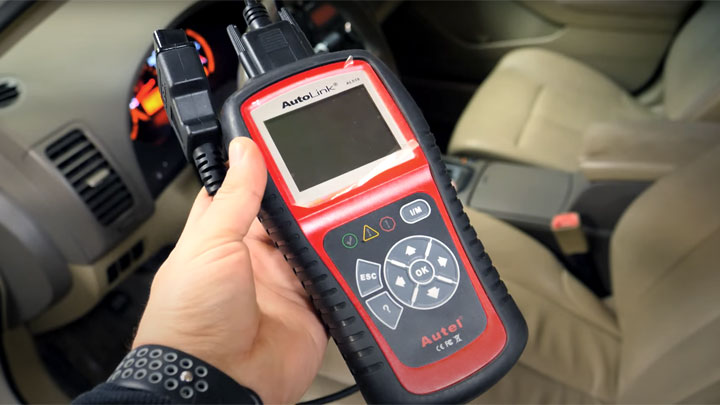P0308 Code (Symptoms, Causes, and How to Fix)
A random engine shudder or misfire is alarming but modern vehicles are quite good at recording misfire events, even cylinder-specific. P0308 indicates that cylinder #8 is misfiring.
Here we go over the common causes of a misfire, how serious it is, and how to properly troubleshoot and fix a P0308 code.

What Does Code P0308 Mean?
Diagnostic fault code P0308 signifies one or more occurrences of a misfire event isolated to an engine’s #8 cylinder. Simply put, the affected engine’s #8 cylinder has failed to harbor adequate combustion on at least one occasion, thereby creating a detectable imbalance within the engine itself. Whenever this misfire event occurs, engine performance is hampered, if only momentarily.
In most cases, a cylinder-specific misfire code is not logged until engine speed deviates from that which is anticipated by a range of more than 2 percent. This status (engine speed) is monitored through an engine’s crankshaft and camshaft position sensors, and tabulated by a vehicle’s ECM/PCM.
Related: P0300, P0301, P0302, P0303, P0304, P0305, P0306, P0307
Symptoms of Code P0308

Diagnostic fault code P0308 is often accompanied by a host of secondary symptoms, some of which tend to be more troubling than others. Recognizing these symptoms can prove to be of significance when attempting to diagnose the issue at hand, in an expedited fashion.
The following are several of the most common symptoms associated with diagnostic fault code P0308.
- Rough or erratic idle
- Limited engine power
- Starting issues
- Hesitation under load
- Increased fuel usage
Causes of Code P0308
Diagnostic fault code P0308 can be caused by one of many different underlying issues, a number of which can prove tricky to single out. Understanding the potential causes of DTC P0308 can be of substantial worth when attempting to remedy your engine’s annoying misfire.
The following are several of the most common causes of diagnostic fault code P0308.
- Compromised spark plug/plug wire
- Grounded coil pack
- Faulty fuel injector
- Loss of compression
- Blocked EGR passages
- Vacuum leaks
- Faulty engine speed sensor
- Malfunctioning O2 sensor
- Compromised catalytic converter
- Faulty PCM
Is Code P0308 Serious?
Diagnostic fault code P0308 is typically considered to be of moderate severity. This is due to the possible implications that repeated misfire events can have on a vehicle’s driveability. In the most severe of cases, an engine can actually fail to start or stall intermittently, if a cylinder-specific misfire were to become relatively frequent in nature or worsen in severity.
Another possible risk associated with persistent misfire events is the threat of eventual catalytic converter failure. This issue can arise when unburnt fuel is directed downstream through a vehicle’s exhaust, where it collects within the exhaust catalyst itself. This fuel is then superheated, leading to potential internal catalyst failure.
In any event, the root cause of a vehicle’s P0308 diagnostic fault code should be thoroughly diagnosed and repaired as soon as possible. Doing so can quite possibly prevent you from becoming stranded alongside the road, while also mitigating the risk of incurring the need for additional repairs that would otherwise be avoidable.
If you do not feel comfortable tackling such repairs yourself, an appointment should be made with a trusted service center as soon as possible.
How to Fix Code P0308

The following steps can be followed to assist in diagnosing and repairing the root cause of a vehicle’s P0308 diagnostic fault code. As always, be sure to consult factory-specific service literature for your particular model of vehicle before conducting any such repairs.
#1 – Scan For Additional DTCs
Before beginning the diagnostic process, check for the presence of any additional diagnostic fault codes. Any such codes should be thoroughly diagnosed and repaired before proceeding.
#2 – Inspect/Test Ignition System Components
Begin the diagnostic process by carefully inspecting your engine’s #8 ignition coil/coil pack for signs of arcing or obvious damage. In addition, the corresponding spark plug and plug wire for this respective cylinder should be inspected as well.
Other points of interest within the ignition circuit include an engine distributor cap and rotor button, if so equipped. Any of the abovementioned components, that exhibit signs of excess wear or damage, should be replaced.
#3 – Qualify Fuel Injector
Next, it will be necessary to verify the #8 fuel injector’s functionality. This can be done by cycling the fuel injector in question, with the use of a bi-directional scan tool, while motoring a fuel rail-mounted pressure gauge.
A momentary drop in fuel pressure should directly follow the activation of this fuel injector. A failure to observe this drop in pressure would indicate a faulty injector or compromised fuel injector control circuit.
#4 – Verify Compression
If the above steps have failed to reveal any points of concern, a full-scale engine compression check will be necessary. Compression readings taken at the #8 cylinder should be compared to those taken at every other respective cylinder.
The difference between these readings should be within specification, as detailed by your vehicle’s manufacturer.
#5 – Analyze Freeze Frame Data
It can also prove helpful to study any and all freeze frame data related to the recorded P0308 fault code. This can provide helpful insight into any potential out-of-range sensor readings that could have possibly triggered a false #8 misfire to be registered.
Sensor values of interest include those pertaining to the MAF sensor, camshaft position sensor, crankshaft position sensor, and O2 sensors.
- P0480 Code (Symptoms, Causes, and How to Fix) - Apr 19, 2024
- Car Temperature Gauge Stopped Working? (Here’s Why) - Apr 15, 2024
- Ignition Coil vs Coil Pack (What’s the Difference?) - Apr 8, 2024
